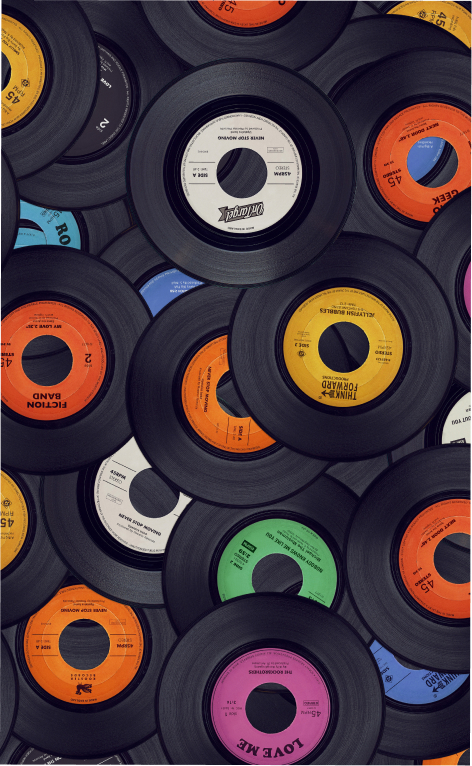Vinyl records are an integral part of music, in spite of MP3, WAV, and the like. Black records have more style than colorless bits & bytes from a computer. You can hold a record in your hand, watch it spin around on the turntable, and experience how clear, crisp sound is created from a single groove. Vinyl remains the first choice in DJ culture, but samples from old records have long been standard in music productions as well. As such, vinyl is not only a nostalgic medium, but has timeless value. Unfortunately, vinyl records themselves are not as timeless. The better they are, the more often they are played, which means the more intensively the ravages of time wear away at them. The result is crackling, popping, and hissing. What provides analog warmth in moderation can be annoying in the long run. And one, single severe scratch will put an end to analog playback forever. There's a simple solution: Digitizing records. This is not as a digital replacement, but simply a backup.
And for all DJs and music producers, this provides a resource for remixes, sample collections, compilations, and playlists.
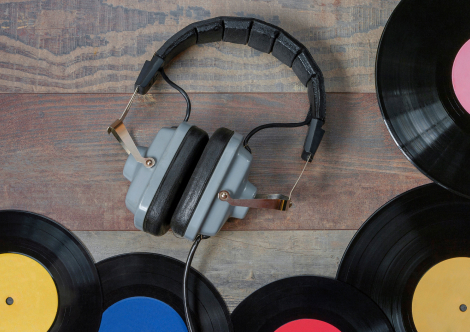
What do you need to digitize records?
The principle is quite simple: Play a record and record it with the computer. To do this, you need a good record player and a standard computer or laptop. A preamplifier must connect the them, because the audio signals from the record player need to be amplified before they can be processed further. This procedure is called “RIAA equalization”.
And finally, you need an A/D converter to convert the electrical signals into digital zeros and ones that can be read by the computer. Naturally, you can also use the input of your computer sound card for this purpose, which contains an A/D converter. Unfortunately, this is usually not of very high quality. If you're going to the trouble of using a good turntable, you shouldn't skimp on A/D conversion.
You will need:

Record player:
The higher the quality, the better. High-end turntables, however, can easily cost a small fortune – this is one disadvantage of analog technology, which thrives on expensive materials, meticulous workmanship, and complicated power ratios. But good turntables can be rented. Ask in a hi-fi store near you. This is the ideal solution to transfer a complete record collection onto the computer within a month.

Computer/laptop:
There is nothing special to consider in this regard – a standard, modern computer with Windows 10 or 11 will completely do the job.

Phono pre-amp with an A/D converter:
The preamplifier amplifies the signal from the turntable, the A/D converter transforms the analog signal into a digital one. The easiest way is to use devices that combine both – a phono preamplifier and an A/D converter. Alternatively, you can buy them separately or use the preamplifier on your turntable or receiver, for example. There are several options, so take a close look at your equipment. If your hi-fi amplifier (receiver) has a phono input, it means that there is a built-in preamplifier. Then, all you have to do is connect the turntable to the phono input and you can connect the line-out jack to an A/D converter.

Software:
You also need the appropriate software to record the audio signal. There are many options, ranging from freeware tools with limited functionality to high-end audio software that can do it all.
In the middle, we recommend an affordable specialized solution: SOUND FORGE Audio Cleaning Lab. It not only lets you record your records, but enables you edit them with custom tools as well. This includes brightening up dull sound, filtering out noise, reducing crackling, removing pops, cutting songs, and more. It uses authentic, professional effects that are normally only available in expensive studio software.
Vinyl to bytes: Digitize in just three steps
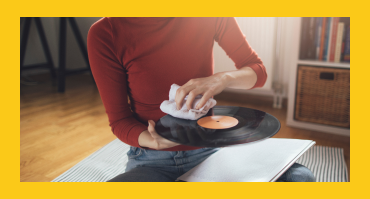
Step 1: Clean the vinyl. For the best possible sound quality, you should first clean the records that you want to digitize. You have several options here. The easiest way to clean it is with a record brush. If you don't have one, you can buy one on the Internet or in a hi-fi store at a low price.
Another alternative is to clean your records with a damp cloth. Don't use dish detergent, but instead use a special cleaner for records. Use a microfiber cloth to wipe the cleaner and any dirt off the record. Always wipe following the path of the groove! In the case of valuable individual records, it would be best to use a cleaning service at a record store you can trust.
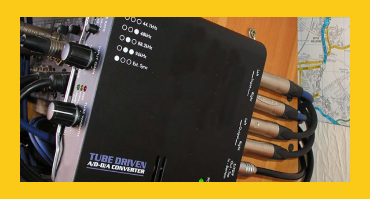
Step 2: Connect the devices. Next, connect your devices:
- the record player with the preamplifier (you can also use the phono input of the hi-fi system)
- the preamplifier (or the hi-fi receiver output) to the external A/D converter
- the external A/D converter with the computer, in most cases via USB
Depending on the equipment, the wiring may be different. In many cases, the amplifier and A/D converter are combined in one device. There is also occasionally a digital output on the hi-fi receiver or turntable, in which case you can connect this output directly to the computer.
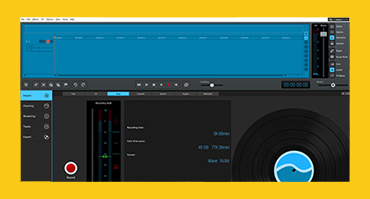
Step 3: Record LP. Start your computer and SOUND FORGE Audio Cleaning Lab. When you open the program, the "Import" tab will be displayed and is the best place to start. Switch to "Vinyl" at the top and play the record briefly to check the input signal.
If everything is fine, record the first side. To do this, click on the red record button. At the end, press "Stop" and then record the second side.
By default, you are recording in uncompressed WAV format, which is recommended: This format offers the highest quality. However, you can also change the recording format in the "Settings" and make your recordings in a more space-efficient format, for example OGG or MP3.
Basically, you're already done – your record is available digitally as an audio file on your computer. If you wish, you can clean up the recording with different features, improve the sound, split it into individual tracks, and export it as MP3 or burn it as an audio CD, for example.
Tip: Once you have digitized an extensive record collection, it makes sense to archive the digitized music on a hard drive with a music management program. This allows you to search for specific titles and avoid becoming overwhelmed by the countless folders of music on your hard drive.
Hissing, crackling, and popping:
How to remove the signs of age after digitizing
Maybe not all your records are in the best condition. Particularly older rarities tend to pop and crackle. After digitization, it's possible to edit your recordings with specialized tools so that the sound is clean, clear, and modern. With infinitely adjustable controls, you can set the effects to anything from a minor adjustment to a full filter. A spectral display of the audio material assists you in this process. It clearly visualizes the different frequencies of the recording, so that you can recognize noise upon first glance and easily remove it.
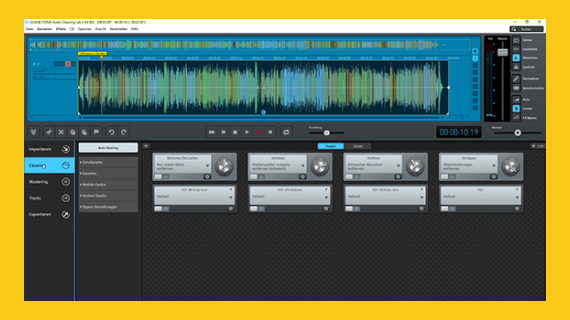
Hissing, crackling, and popping - the Cleaning effects
If desired, it's possible to thoroughly restore the sound of your digitized records (as well as any other audio file). SOUND FORGE Audio Cleaning Lab provides the following special effects for this purpose:
- DeClicker/DeCrackler: Eliminates loud pops and crackles
- DeNoiser: Remove all types of constant noise (e.g. power humming or hissing)
- DeHisser: Remove high-frequency noise, which is characteristic of tape recordings
- DeClipper Eliminates digital or analog clipping and sibilants
- RX 8 DeHum: A built-in VST plug-in to eliminate humming and buzzing, e.g. caused by alternating current with insufficient electrical grounding
- eFX DeEsser: An included VST plug-in against loud "ess" and sibilants, particularly in vocal recordings
- RX 8 DeClick: A included VST plug-in to remove clicking noises
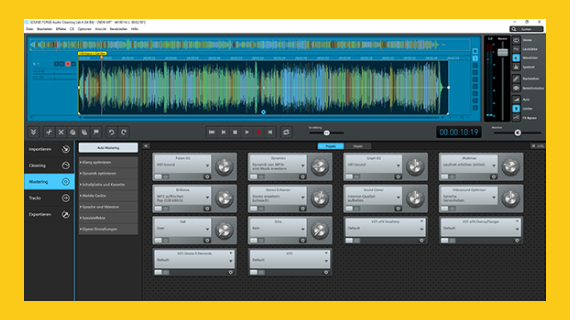
Transparent, brilliant & powerful - the Mastering effects
It is also possible to enhance the sound, make it punchier, or even remaster it completely. The following mastering functions are available for this purpose:
- Parametric & graphic EQ: Two different equalizers for the precise adjustment across all frequencies.
- Dynamics & Multimax: One standard and one multiband compressor for more loudness, sound pressure, and improved volume relationships
- Brilliance enhancer: A professional filter to make dull sound more sparkly and brilliant with additional harmonics
- Sound Cloner: A professional tool to transfer the sound characteristics of desired music files to other audio media.
- Ozone 9 Elements: An included professional mastering plug-in by iZotope, which would cost over €120 separately (as of September 2022)
And a number of other special effects: Vocal Strip for voice recordings, Videosound Optimizer for video soundtracks, reverb, echo, chorus/flanger, and a free slot for your own VST plug-ins.
Your LPs are digitized, the sound has been cleaned up – what now?
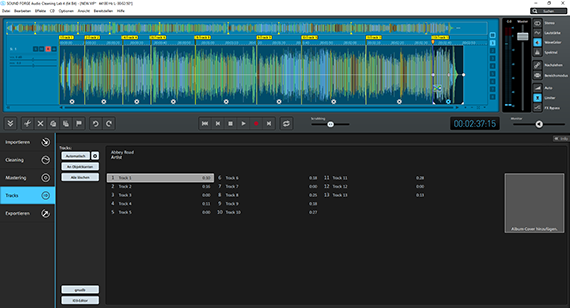
Cut records into tracks and export them
Of course, you don't always have to listen to your digitized records all the way through. With SOUND FORGE Audio Cleaning Lab, it's possible to cut them into individual tracks and create a custom tracklist with songs from records or other audio files. This is done in the "Tracks" area.
Selling vinyls
A record collection requires a shelf or cabinet measuring 31.5 cm × 31.5 cm x the width of your collection of records. A digitized collection requires virtually no space at all. Perhaps you're thinking about selling your expansive treasure trove of vinyl. If you want to sell your vinyl collection, you can use online music marketplaces like Discogs or Vinool. Classic auction websites like Ebay are also good options. But local record stores are usually happy to accept your treasures as well to make them available to other enthusiasts.
To estimate the value of your records, use the Internet: Search for your records on Ebay, for example, and compare the offers. Is there a lot of interest? For which price was the record sold? Is the condition similar to your vinyl?
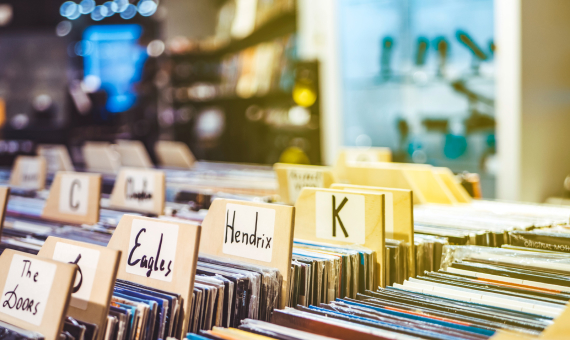
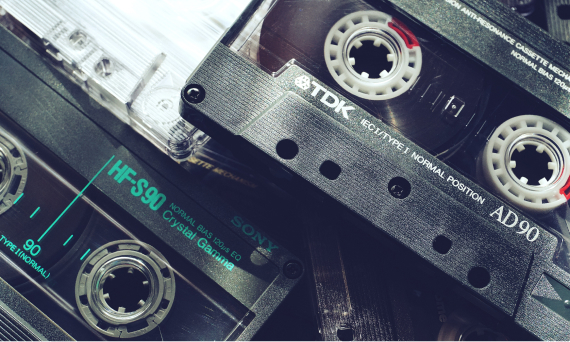
Digitize cassettes
And think about your cassette collection – it isn't getting any better with time either. Recordings on magnetic tapes fade with time and "get erased". Mechanical problems like tape jam can also be dangerous for them. Then, why not browse your collection of cassettes for recordings worth preserving and transfer them to your computer? Besides, you're legally protected when you do this.
Section 53, paragraph 1 of the Act on Copyright and Related Rights (UrhG) states that purchased CDs, records, and cassettes that are privately owned can be copied for private use.
Vinyl fun facts
- The history of vinyl: The first record was published in 1887 and produced by the forefather of all record players, Emil Berliner. It was not made of vinyl, but rather of zinc. This was followed by records made of copper, celluloid, hard rubber, and shellac, until vinyl became the predominant material starting in 1948.
- Precious needles: The needle of the record player is set in vibration by the record's groove. This generates the sound. To ensure that the groove's transmission to the needle is as precise as possible, record player needles are made of very fine, precious material: Sapphire or diamond.
- The oldest record store:Spillers Records in Cardiff, Wales. It's been possible to buy records here continuously since 1894.
- The all-time best-selling LP: "Thriller" by Michael Jackson at 108 million copies sold.
- The revival of vinyl: So much for nostalgia: Vinyl is the most profitable form of analog music distribution. In 2019, more records were sold than CDs or cassettes for the first time since 1986. In the first six months of 2019, the music industry generated $224.1 million from record sales. Half of all buyers are under 25 years old.
- The most expensive vinyl record: The Beatles – of course – rank at the top of the list for the most expensive records of all time. The most expensive vinyl record ever sold at auction is the first pressing of the "White Album" bearing the serial number 0000001 for just under $800,000. "That'll Be The Day" and "In Despite All The Danger" by The Quarrymen, a band formed by John Lennon and four school friends in 1956, sell for $354,000 on the market. For Elvis Presley's debut single "That's All Right", it's still possible to get over $12,000.
- The fastest record: The two records located aboard the Voyager 1 and 2 space probes have made the most distance. They are made of gold and were produced as messages in the hope that any intelligent extraterrestrial life forms might thereby learn of humanity and its position in the universe. Voyager 1 is already over 18 billion kilometers away with its record – and still flying. Currently, the record is traveling at about 61198.2 km/h airspeed.
- The largest record collection: Zero Freitas, Brazilian entrepreneur, had collected 3,000 records by the end of his high school education. Today, he owns about 6-8 million records. His goal is to own a copy of every record in existence.
- Rest in vinyl: The British company "And Vinyly" offers the possibility to be buried on a record. In the basic package for £3000, you can have yourself pressed onto a record together with the audio of your choosing after you have passed away and been cremated.
